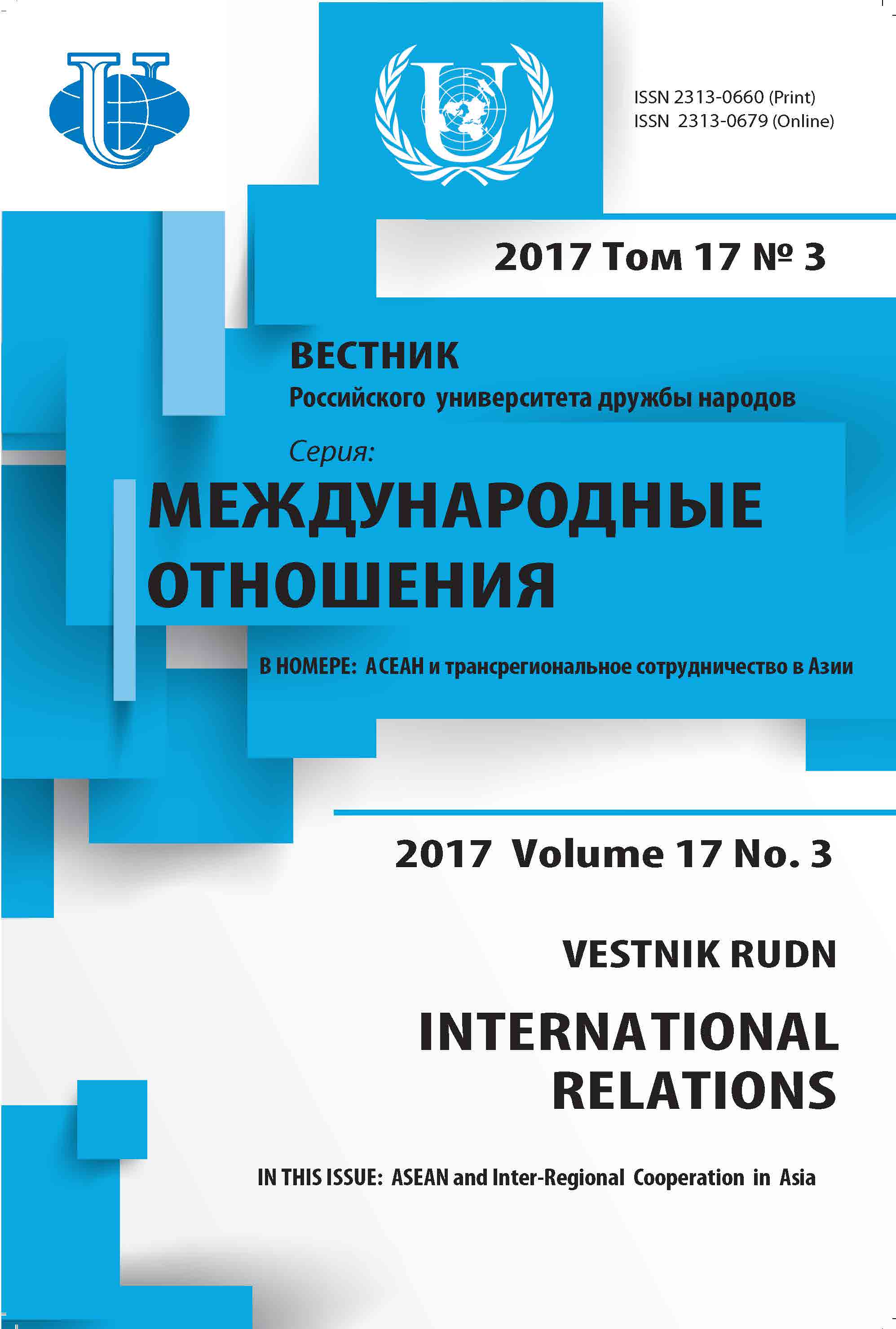THE DUAL-TRACK APPROACH OF THE PRC TO THE RESOLUTION OF DISPUTES IN THE SOUTH CHINA SEA
- Authors: Ponka TI1, Belchenko AS1, Trusova AA1
-
Affiliations:
- RUDN University (Peoples Friendship University of Russia), Moscow, Russia
- Issue: Vol 17, No 3 (2017): ASEAN and Inter-Regional Cooperation in Asia
- Pages: 518-529
- Section: PEACE AND SECURITY
- URL: https://journals.rudn.ru/international-relations/article/view/16764
- DOI: https://doi.org/10.22363/2313-0660-2017-17-3-518-529
Cite item
Full Text
Abstract
The Asia-Pacific region is becoming one of the centers of global economic and political development. Countries of the region actively develop their economy, implement democratic reforms, and are also interested in peace and security in the region. A serious destabilizing factor in the Asia-Pacific region is territorial disputes between China and a number of countries in the region. China is taking the lead in the region and resolutely defends its interests, including territorial ones. The growing economic and military strength of China bothers other countries of Asia-Pacific region. Japan, Vietnam, South Korea, Indonesia also claim regional leadership. They also demonstrate determination in their territorial claims. Confrontation with China encourages the countries of the region to seek political and military support from the US, that could lead to the aggravation of the situation in the region in future. Meanwhile, China is also interested in good relations with neighbors, that’s why it changes approaches of solving its territorial issues. The objective of the research is to define China’s approach to territorial disputes in Asia-Pacific region. For this purpose, the authors set some tasks: first, to point out the main territorial disputes between China and Asia-Pacific countries, second, to consider how the problem of territorial disputes in Asia-Pacific region first appeared and developed, and how the Chinese government reacted to it, and finally, to analyze the role of international organizations, such as the UN and ASEAN in settling disputes in Asia-Pacific region. Summarizing the results of their research, the authors make the important conclusion that China’s stance on disputed territories remains unchanged, and at the same time, Chinese government seeks to solve the existing territorial problems peacefully, without using military force.
About the authors
T I Ponka
RUDN University (Peoples Friendship University of Russia), Moscow, Russia
Author for correspondence.
Email: ponka_ti@rudn.university
PhD in History, Associate Professor of the Department of Theory and History of International Relations of Peoples’ Friendship University of Russia (RUDN University)
A S Belchenko
RUDN University (Peoples Friendship University of Russia), Moscow, Russia
Email: belchenko_as@rudn.university
PhD in History, Associate Professor of the Department of Theory and History of International Relations of Peoples’ Friendship University of Russia (RUDN University)
A A Trusova
RUDN University (Peoples Friendship University of Russia), Moscow, Russia
Email: 1032152385@rudn.university
student of the Department of Theory and History of International Relations of Peoples’ Friendship University of Russia (RUDN University)
References
- Danilov, B.Y. (2006). Asian arc of instability in the beginning of XXI century. Vostok. Afro-aziatskie obshchestva: istoriia i sovremennost (Vostok (Oriens), 6, 160—163. (in Russ).
- De Castro, R. (2016). The challenge of conflict resolution in the South China sea dispute: Examining the prospect of a stable peace in East Asia. International Journal of China Studies, 7 (1), 23—51. DOI: https://doi.org/10.1177/0920203x16665054.
- Hong, N. (2016). The South China Sea Arbitral Tribunal Award: Political and Legal Implications for China. Contemporary Southeast Asia: A Journal of International and Strategic Affairs, 38 (3), 356—361.
- Jung, S.C. & Lee, K. (2017). The Offensive Realists Are Not Wrong: China's Growth and Aggression, 1976—2001. Pacific Focus, 32 (1), 86—108. doi: 10.1111/pafo.12088.
- Kanaev, E.A. (2007). Conflict over the islands in the South China Sea: the history, the nature of the settlement, prospects of evolution. Moscow: Gotika publ. (in Russ).
- Korsun, V.A. (2013). The Evolution of Approaches of the Chinese Leadership to the Problems of Present-Day Borders of the PRC. South-East Asia: Actual Problems of Development, 21, 16—22. (in Russ.).
- McCoy, A.W. (2016). Circles of Steel, Castles of Vanity: The Geopolitics of Military Bases on the South China Sea. The Journal of Asian Studies, 75 (4), 975—1017. DOI: https://doi.org/10.1017/s0021911816001601.
- Mosyakov, D.V. (2013). Conflict in South China Sea and ways of decision. South-East Asia: Actual Problems of Development, 21, 16—22. (in Russ).
- Ponomarenko, L.V. & Ponka, T.I. (2014). On the question of Sino-Indian relations in the end of 20th century — beginning of 21st century. Prospects of science and education development: Collection of treatises on the materials of the International Scientific and Practical Conference on January 31; Tambov: Bussiness-Science-Society, p. 65—69. (in Russ).
- Shirley, V. Scott (2016). China’s nine-dash line, international law, and the Monroe Doctrine analogy. China information, 30 (3), 296—311. DOI: https://doi.org/10.1177/0920203X16665054.
- Trifonov, V.I. (2012). The situation in the Asia-Pacific: the clash of the lines on cooperation and confrontation. Kitai v mirovoi i regional'noi politike. Istoriya i sovremennost'. Vol. XVII. Mos¬cow: IFES RAS, 29—44. (in Russ).
- Valencia, M.J. (2007). The East China Sea dispute: Context, claims, issues, and possible solutions. Asian perspective, 31 (1), 127—167.
- Voloshina, A.V. (2015). Northeast Asia in modern foreign policy strategy of China. Problems of the Far East, 6, 12—24.
- Yates, R. (2016). ASEAN as the ‘regional conductor’: understanding ASEAN's role in Asia-Pacific order. The Pacific Review, 30 (4), 443—461. DOI: http://dx.doi.org/10.1080/09512748.2016.1264458.











